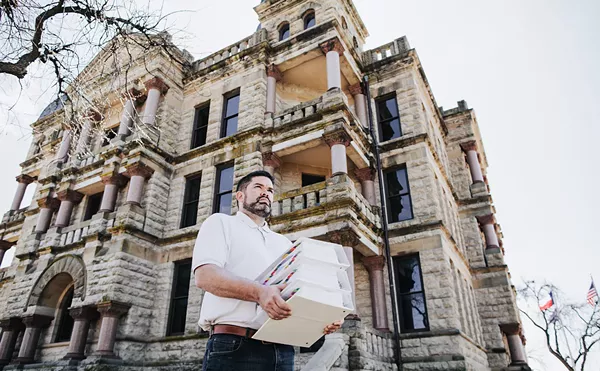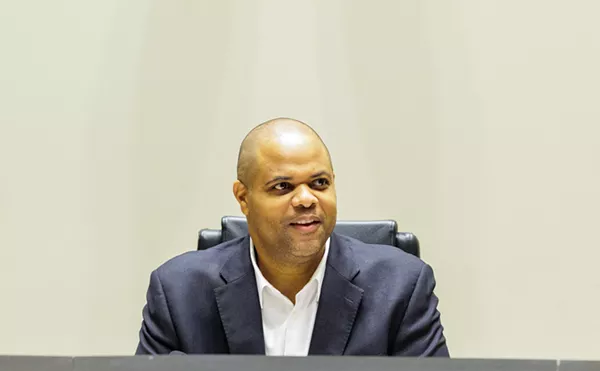City Hall starts off last week giving one of its typical bureaucratic blow-offs to plans for bike lanes throughout the city. At a briefing before a city council committee, staff experts tell the council members that bike lanes would be hugely expensive. Sorta can't be done. Big legal headache. Maybe just forget about it.
By the end of the week — barely days later — City Hall is already backing down. Now they're saying it can be done and, by God, they're gonna do it. Maybe.
Hey, that may not sound like major action to you, and I'm not calling it an earthquake, but it's definitely a tremor. It's a very interesting tremor.
The bike plan now is the emblematic, frontline, eyeball-to-eyeball standoff between the old Big-Hair Tail-Fins Dallas and the new Gen X Thirtysomething Back-to-the-City Dallas.
Don't look now, but Big-Hair just blinked.
It's a blink demonstrating something very exciting. It means this city is getting smarter. It will be cooler. Dallas will become a much better place to live, and this is all about how it's happening.
Dallas now is almost alone among major American cities for having zero miles of marked bike lanes. Last June, the council unanimously adopted a plan calling for 840 miles of bike lanes all over the city, but last week a top city official told the council committee that painting bike lanes on city streets would cost $16 million, would take many years and involve endless public hearings and neighborhood battles.
Theresa O'Donnell, director of the Department of Helping Developers (not its real name) told the council's Quality of Life Committee (its real name) that City Hall has no money to pay for the plan. In so saying she sort of made fun of them all.
"There was not funding identified [when the plan was adopted six months ago]," she said. "It was not a fiscally constrained plan."
So it was what? A fiscally just-flopping-around-out-there-loose plan? That's kind of what she said. "This was the ideal plan," she said. "This was my daughter's Santa Claus list."
Oh, ouch! That's kind of like telling the committee to grow up. But, listen, the PowerPoint presentation she gave them was an even worse beat-down.
The committee had been especially interested in bike lanes for Fort Worth Avenue in Oak Cliff, particularly the end of the street nearest the river, because a lot of hip new-urban redevelopment is happening there. If we're tearing up Fort Worth Avenue, rebuilding and restriping it anyway, why not paint on some bike lanes?
According to O'Donnell's PowerPoint, painting bike lanes on that 1.29-mile stretch of Fort Worth Avenue would cost $32,000. But then, because of various legal issues involving the city's thoroughfare plan, you'd have to scrape all of that off 180 days later and repaint. Really. The scraping off and repainting would cost another $30,000.
Then you'd have to hold a series of public hearings and legal reviews to see if you could paint the bike lanes back on again permanently. Really. Unsure how much the hearings would cost, but not free.
Then, if the hearings went OK, you could paint the bike lane stuff back on for another $32,000, but it might be more, because of course you'd have to pay to scrape off the other new paint you just put on, really.
The PowerPoint said you'd have to redo the bike stripes every four years at a cost of $29,000, and you might have to do special sweeping and maintenance on an ongoing basis.
So anyway, you'd be up around $100,000 right off the bat, more money not too much later and who knows how many years it would take to get it all done? And who knows what outcome you would find yourself stuck with after opening the whole thing up to neighborhood politics on a block-by-block basis? Seems less like a bike plan than a communist plot to give the city a nervous breakdown.
I did a little quick jotting. According to the Fort Worth Avenue scenario painted by O'Donnell, the total tab for 840 miles would come out somewhere between $65 million and a kabillion dollars, and the plan wouldn't be completed until after our planet has been invaded by alien life-forms who need our hair and toenail clippings to power their starships, so who needs a bike plan then anyway?
Wow. That's just terrible! Terrible! No wonder there are no bike lanes anywhere in America! No wonder no one has ever even heard of a bike lane in America! Oh, wait! That's not true, is it?
New York City has doubled its bike lanes to 400 miles in the last five years. Boulder, Colorado, has rendered 95 percent of the streets in the whole city "bike-friendly." Chicago has 12,000 public bike racks and 141 miles of bike lanes.
Are they all just fools? Are they spending themselves into the grave? I got on the horn and called some of these bizzaro places that have bike lanes and asked them: Are you just a bunch of lunatics? What is it costing you to put in all these zany bike lanes, and don't you have to hold endless public hearings ad nauseum until the alien life-forms come to harvest your toenails for their starships?
Mike Cynecki, a recently retired traffic engineering supervisor for the city of Phoenix, who was over their bike plan for years, said he estimated the cost of bike lanes somewhere in the neighborhood of zero.
Zip. Goose egg.
Phoenix has 187 miles of marked bike routes, 55 miles of paved and unpaved paths and 222 miles of on-street bike lanes. Obviously the city has to pay to build the separate bike paths, but not the bike lanes, he said.
Cynecki told me Phoenix simply requires by policy that any time a new street is built or an old street is resurfaced, it has to be painted with bike stripes.
Hmm. True, you have to paint it with some kind of stripes. Why not bike lane stripes? Cynecki said in Phoenix painting the bike stripes is just considered part of the cost of building and maintaining the street anyway.
"All of the standard [design requirements] for our surface streets now include on-street bike lanes for new streets, so a developer coming in would build that."
Of course, at first that would produce a patchwork, but urban streets need to be resurfaced every four years. "At some time in the future the city would come by and build the matching section," Cynecki told me.
He said you also have to maintain the street anyway. So how much more does it cost to maintain the street because there are bikes on it? Do bikes wear out the street more than cars do? Cynecki said no.
"We never had a separate budget item that was meant for bike-lane maintenance," Cynecki told me.
I talked to another Arizona guy, Reed Kempton, a senior traffic planner for the city of Scottsdale, who gave me some detail on how they have created their 124 miles of marked bike lanes. Basically they did what Phoenix did: They just wrote bike lanes into the street design.
"If you are not moving any curbs, it really is not very expensive," he said. "You still have a centerline. You still have your travel lane markings, and typically you will put down an edge-line, so that people can see the white line before they hit the curb and gutter.
"So it's simply a matter of how far that outside line goes away from the curb and gutter. We put it four and a half feet out, so it becomes a bike lane."
Voila! Free bike lane. Almost. You still have to put little bike symbols in the pavement and some signs along the curb. According to my own research, the Dallas bike plan seems to call for way more bike symbols and signs than what's currently required in the standards of the American Association of State Highway and Transportation Officials and also seems to price the bike symbols at almost five times the going rate. But even at that, Kempton said, little bike-symbol pavement markings shouldn't stop you cold.
"If you do a two or three million dollar project," he said, "the cost of pavement markings is pretty insignificant."
Now, that's in America. What about here in Texas? I talked to Preston Tyree, a retired chemical engineer and former education director for the League of American Bicyclists. The league is in Washington, D.C., but Tyree lives in Austin, a city that has completed almost a third of a 750-mile bike lane plan.
Tyree told me Austin has done it the same way the Arizona cities did, by writing bike lanes into the required city street design.
"You don't have to spend all that money," he said. "You say, 'I'm not going to do anything unless I'm already repaving that road.' And, yes, you wind up with funny little pieces, but eventually it all gets together, and over time it works."
By the way, one thing struck me as he was speaking. O'Donnell told the Dallas council committee any new bike lanes would require public hearings because they would conflict with the city's thoroughfare plan, and any time something conflicts with the thoroughfare plan you have to hold a hearing.
So what about changing the thoroughfare plan? You know, putting bike lanes into street designs in the thoroughfare plan like all these other cities have done? Then there's no conflict. Problem solved? Just a thought.
But here's the great thing. All this stuff I was finding out for the first time by doing my reporting was already well known to people like Jason Roberts of Bike Friendly Dallas, city council member Scott Griggs of Oak Cliff and council member Angela Hunt of East Dallas.
Roberts, in particular, understands that this whole new way of building the city — making it harder for cars to move inside the city, easier for pedestrians and bikers — is a foreign language to most of the city's professional staff.
"Multimodal infrastructure is really a post-'90s kind of model for development," he told me. "The education for it didn't happen until much later. For a lot of these guys who are in place now [in City Hall], a lot of these ideas are actually completely counter to everything they learned.
"We're saying you're going to have slow traffic a bit more, invite more people into the mix, actually create potentially more conflicts," Roberts said. "All of those are foreign concepts to these people, so what's happening is that they're nervous. They're scared. They really don't want to do those things."
Griggs, the new Gen X council member from Oak Cliff, sees it as a fundamental conflict of values. "We can build a half-a-billion-dollar convention hotel. If we really want to build bike lanes, the money is not an issue. There are so many ways to do it cheaply and fast."
I am aware that those views were being conveyed to city officials all week long after the bad briefing. At the end of the week, I called Hunt, who had seriously good news. She told me she had conferred with City Manager Mary Suhm, and Suhm was now talking a line that sounded much more like what Austin and the Arizona cities have done.
"I talked to Mary," Hunt said, "and she indicated to me that, since we have a bike plan that was overwhelmingly approved, it will in the future be included in any street costs, and the expense will be incremental."
Later, in response to my request for comment, I received a speakerphone call from Suhm and O'Donnell, the director of helping developers. They told me O'Donnell's presentation to the committee earlier in the week had been egregiously misconstrued by reporters (I hate those guys), and "We're going to take every opportunity we can to make bike lanes."
Last Friday Robert Wilonsky, editor of our news blog, Unfair Park, was out trolling for catfish on the City Hall web page and found a sort of odd, out-of-the-blue manifesto under the title, "City clarifies Dallas bike plan implementation status and outlook."
It said: "The cost differential between standard street striping and bike facility markings will involve weighing the needs for maintaining existing street striping with the benefits of implementing particular bike routes along key corridors."
May I translate that for you? Do you mind? I've been at this awhile. Here's what that means:
Blink.
The manifesto sounds grouchy. It's pretty grudging. And there's the usual problem: Just by looking at the words, it's impossible to figure out what it really means.
But I know what it means. It means blink. It means that Griggs and Hunt and Roberts and probably a bunch of other people I don't even know made it clear to City Hall during the course of last week that Dallas — the new Dallas — wants bike lanes. And it's going to have bike lanes.
That's wonderful. Nothing is easy. Getting City Hall off the dime certainly is not easy. But it can be done. It is being done. Change is happening. Dallas is getting better.
I'm so thrilled, I may even be in a good mood over the holidays. Let me look at a calendar here.












